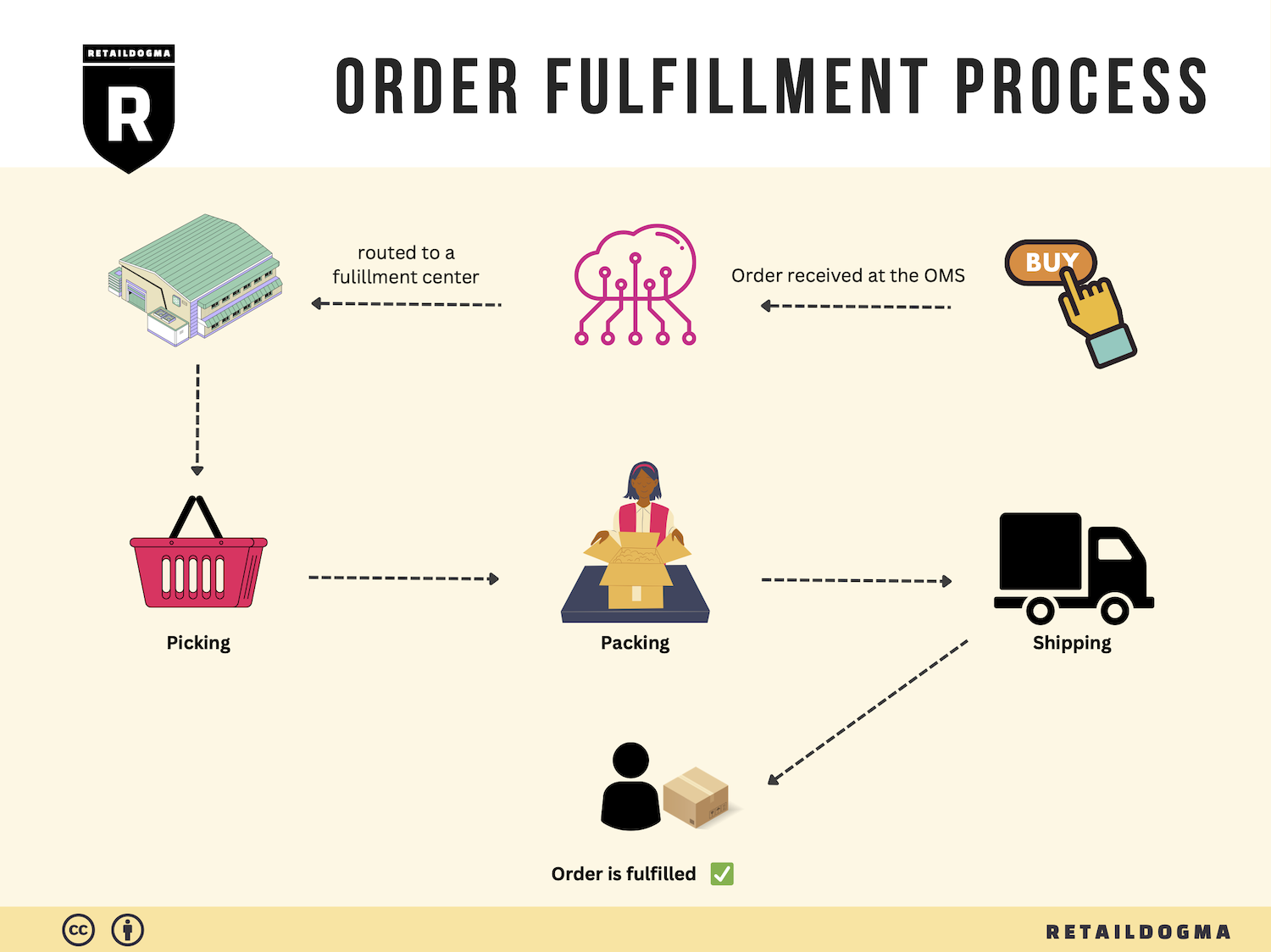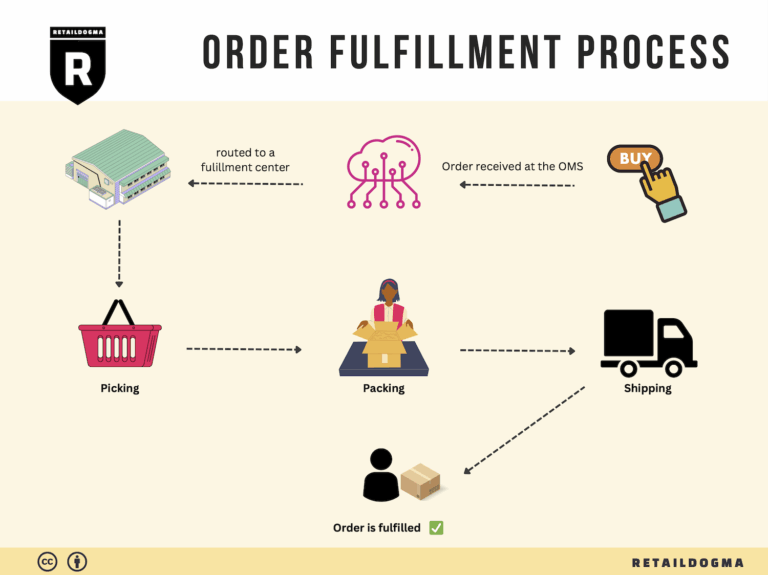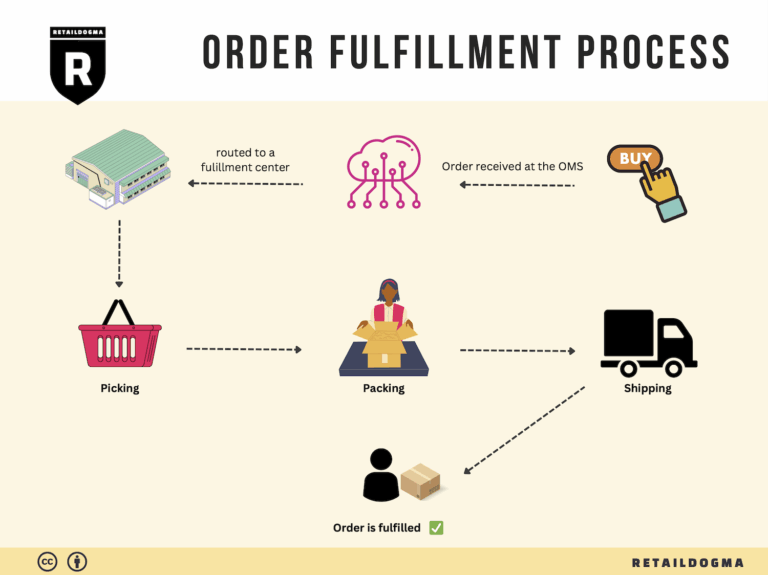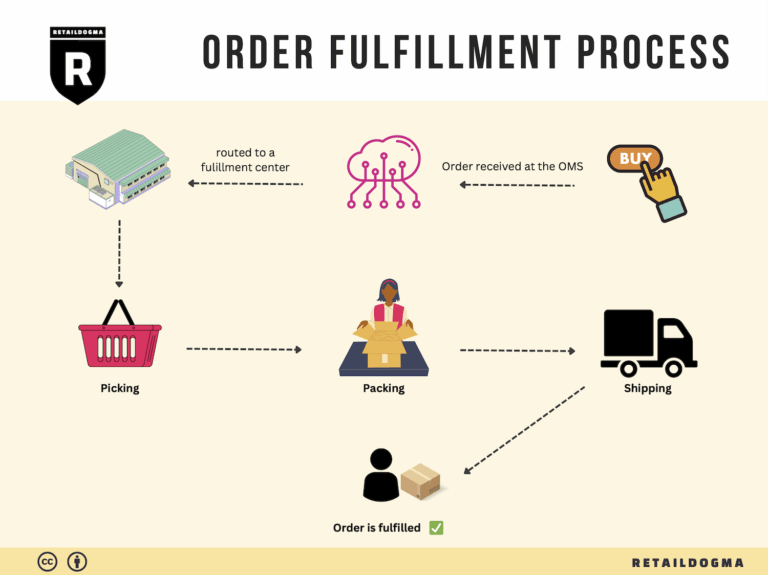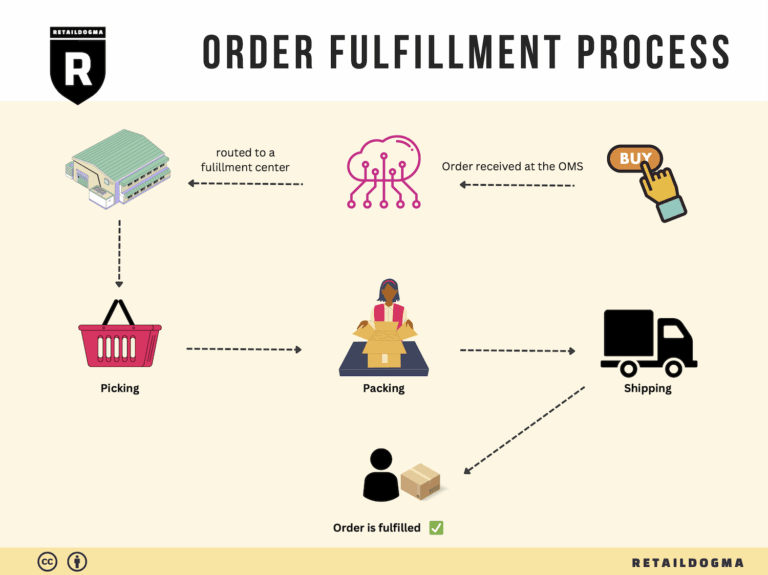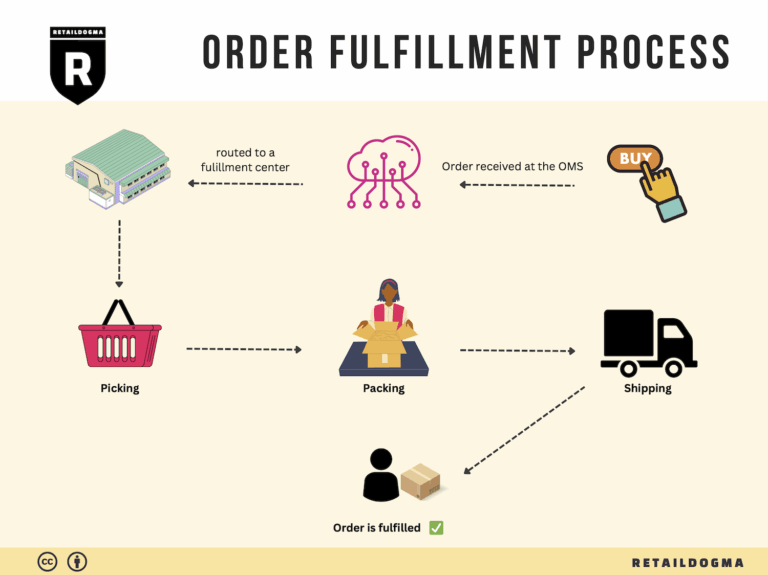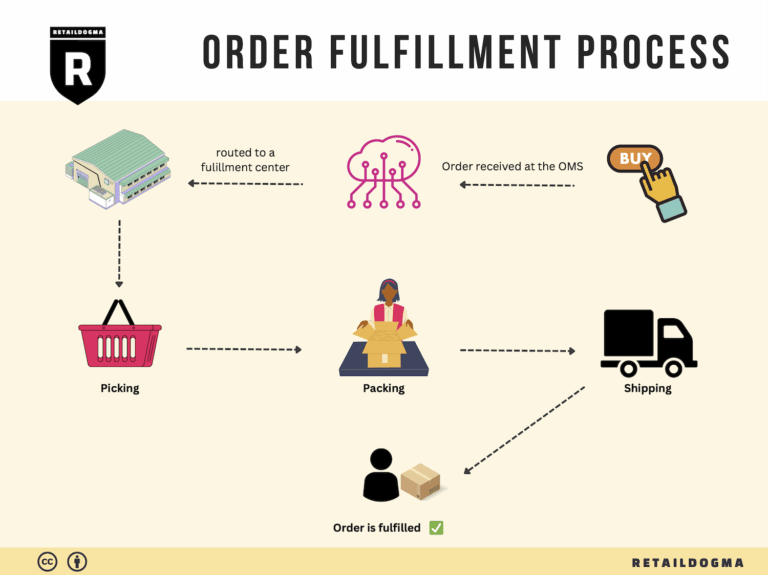How Order Fulfillment Works: A Step-by-Step Guide for Businesses
What is E-commerce Fulfillment? An Introduction for Growing Businesses
Understanding E-commerce Fulfillment: A Key to Business Growth
As an e-commerce business owner, you may find yourself overwhelmed by the logistics of packing and shipping orders. The excitement of growing sales can quickly turn into stress when you face the complexities of getting products into the hands of your customers. This is where e-commerce fulfillment comes into play—essentially the process of getting a product from your inventory to your customer’s doorstep.
In today’s competitive online marketplace, efficient fulfillment is not just an operational necessity; it’s a strategic advantage. A well-optimized fulfillment process can enhance customer satisfaction, reduce operational costs, and ultimately drive revenue growth. However, choosing the right fulfillment strategy can be daunting. Should you manage it in-house, partner with a third-party logistics provider (3PL), or utilize a service like Fulfillment by Amazon (FBA)?
This guide will provide you with a comprehensive overview of e-commerce fulfillment, covering essential topics that every growing business should consider:
-
Fulfillment Models: We will explore various fulfillment models, including in-house fulfillment, third-party logistics (3PL), and FBA. Each model has its benefits and drawbacks, and understanding these will help you align your logistics with your business goals.
-
Core Services: Learn about the core services that fulfillment centers typically offer, such as inventory management, order processing, packing, shipping, and returns management. Knowing what to expect can help you assess potential partners more effectively.

-
Choosing a Partner: Selecting the right fulfillment partner is crucial for your business’s success. We will discuss key factors to consider, including location, technology integration, scalability, and customer service.
-
Pricing Structures: Understanding how pricing works in fulfillment can prevent unexpected costs from derailing your budget. We will break down common pricing structures and help you evaluate what makes sense for your business.
The ultimate goal of this guide is to empower you, the business owner, to make informed decisions about your logistics strategy. By demystifying e-commerce fulfillment and providing practical insights, you will be better equipped to streamline your operations, enhance customer experience, and support your business’s growth trajectory. Whether you are just starting or looking to scale, understanding fulfillment is a crucial step toward achieving your e-commerce objectives.
What You’ll Learn In This Guide
- What is E-commerce Fulfillment? An Introduction for Growing Businesses
- The Order Fulfillment Process: From ‘Buy’ Button to Customer’s Door
- Comparing Fulfillment Models: In-House vs. 3PL vs. Dropshipping
- A Deep Dive into Amazon FBA: Pros, Cons, and Who It’s For
- Core Services Offered by Fulfillment Centers
- How to Choose a Fulfillment Partner: A 6-Point Checklist
- Understanding Fulfillment Pricing: A Breakdown of Common Fees
- Frequently Asked Questions (FAQs) about Fulfillment
- Conclusion: Is Outsourcing Fulfillment the Right Move for Your Business?
- Important Disclaimer
The Order Fulfillment Process: From ‘Buy’ Button to Customer’s Door
1. Receiving Inventory
The order fulfillment process begins with the receiving inventory stage, where goods arrive at the fulfillment center. Upon delivery, each item is checked against the purchase order to ensure accuracy in quantity and quality. This step is crucial because it lays the foundation for inventory accuracy and customer satisfaction.
During this phase, items are assigned a Stock Keeping Unit (SKU), a unique identifier that helps track inventory throughout the fulfillment process. Proper receiving practices help to prevent stock discrepancies and ensure that the inventory levels reflected in your system are accurate. For e-commerce businesses, maintaining accurate inventory counts is vital to avoid stockouts or overstock situations, both of which can harm customer trust and operational efficiency.
2. Warehouse Storage
Once the inventory is received and verified, it moves to the warehouse storage stage. In a fulfillment center like Amazon’s Shakopee facility, goods are stored in a systematic yet often randomized manner. This approach, known as chaotic storage, allows for more efficient use of space and faster retrieval times.
Each item is placed in a designated area, often referred to as a pod or shelf, where autonomous robots can easily access them. The use of robots enhances the speed and efficiency of this process, enabling the fulfillment center to handle a vast array of products. Proper storage practices are essential to minimize the time spent locating items, which directly impacts order fulfillment speed and customer satisfaction.
3. Order Picking
The next step is order picking, where items are retrieved from storage in response to customer orders. This is a critical phase, as it directly affects the accuracy and speed of fulfillment. In high-volume environments like Amazon’s, a pick list is generated, detailing the items and their locations within the warehouse.
Efficient order picking can be achieved through various methods, including batch picking, where multiple orders are picked simultaneously, or zone picking, where workers are assigned specific areas of the warehouse. The choice of picking method can significantly impact operational efficiency and labor costs. By optimizing this process, businesses can reduce lead times and enhance the overall customer experience.
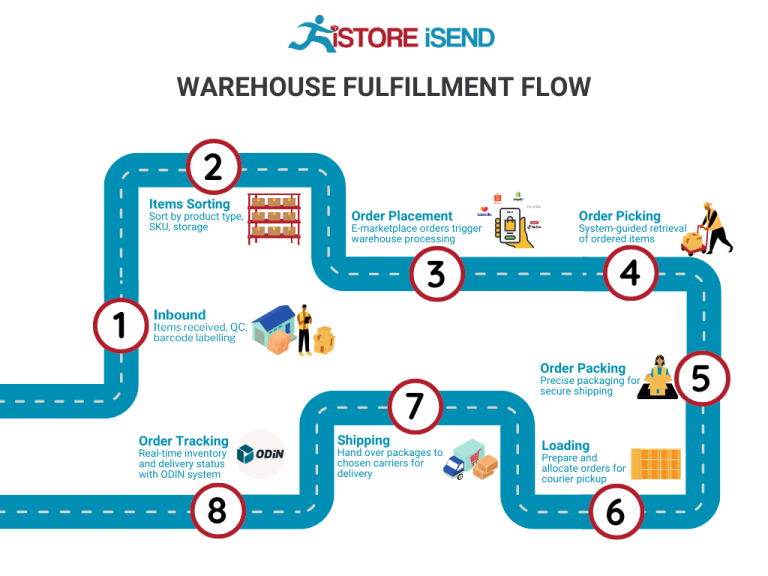
4. Order Packing
After items are picked, they proceed to the order packing stage. Here, the picked items are carefully packed into boxes, ensuring they are secure for shipping. This step is crucial for minimizing damage during transit, which can lead to returns and customer dissatisfaction.
In many fulfillment centers, packing stations are equipped with technology to streamline this process. For instance, packing slips are generated, and items are weighed to determine the appropriate box size. The use of packing lists ensures that all ordered items are included before sealing the box. Efficient packing not only enhances customer satisfaction but also optimizes shipping costs, as correctly sized packages can reduce carrier fees.
5. Shipping & Delivery
The final step in the order fulfillment process is shipping and delivery. Once packed, boxes are labeled with shipping information and placed on a conveyor system that directs them to the appropriate shipping method, whether it be ground, air, or local delivery.
This stage is vital for ensuring timely delivery, which is increasingly important in the e-commerce landscape. Technologies such as tracking systems allow customers to monitor their orders in real-time, enhancing transparency and trust. Additionally, fulfillment centers often utilize a network of distribution partners to ensure that packages reach customers efficiently.
In summary, each step of the order fulfillment process is interconnected and plays a significant role in the overall efficiency and effectiveness of e-commerce operations. By understanding and optimizing these stages, businesses can scale their logistics and improve customer satisfaction, ultimately driving growth and success in the competitive e-commerce landscape.
Comparing Fulfillment Models: In-House vs. 3PL vs. Dropshipping
Fulfillment Model Comparison
| Model | Who Handles Inventory | Best For (Business Stage) | Key Advantage | Key Disadvantage |
|---|---|---|---|---|
| In-House Fulfillment | The business itself | Established businesses with stable sales | Full control over inventory and operations | High overhead costs and resource allocation |
| Third-Party Logistics (3PL) | 3PL provider | Growing businesses needing scalability | Flexibility and expertise in logistics | Less control over inventory and potential misalignment with brand values |
| Dropshipping | Supplier | Startups or small businesses | Low startup costs and no inventory risk | Lower profit margins and reliance on suppliers for quality and shipping |
In-House Fulfillment
In-house fulfillment involves a business managing its own inventory and logistics operations. This model is typically suited for established companies that have a stable sales volume and can support the infrastructure needed for warehousing, picking, packing, and shipping orders. The primary advantage of in-house fulfillment is the level of control it provides. Businesses can maintain oversight of their inventory, ensuring quality and consistency in order processing. Moreover, having direct access to products allows for faster order fulfillment and the ability to customize packaging and branding to enhance customer experience.
However, this model comes with significant downsides. The financial burden of overhead costs, including staffing, warehousing, and equipment, can be substantial, especially for smaller businesses. Additionally, managing logistics requires expertise and can divert focus from core business functions like marketing and product development. As order volumes fluctuate, businesses may face challenges in scaling operations efficiently, leading to either excess inventory or fulfillment delays.
Third-Party Logistics (3PL)
Third-party logistics (3PL) providers offer a service where businesses outsource their inventory management and shipping operations. This model is ideal for growing businesses that require flexibility and scalability without the burden of managing logistics in-house. By partnering with a 3PL, companies can leverage the provider’s expertise in logistics, technology, and warehousing, which can significantly enhance operational efficiency.
One of the key advantages of using a 3PL is the ability to quickly scale operations in response to market demands without incurring heavy capital expenditures. This is particularly beneficial during peak seasons or promotional events. Additionally, 3PLs often have established networks for shipping and distribution, which can lead to reduced shipping costs and improved delivery times.
However, outsourcing logistics means less direct control over inventory management and fulfillment processes. This can lead to potential misalignment with the company’s branding and customer service standards if the 3PL does not fully understand the business’s values. Communication challenges may also arise, particularly if the 3PL is not integrated into the company’s operational systems, leading to issues in order accuracy and inventory visibility.
Dropshipping
Dropshipping is a fulfillment model where the retailer does not hold inventory but instead transfers customer orders directly to a supplier or manufacturer, who then ships the products directly to the customer. This model is particularly attractive for startups or small businesses looking to enter the market with minimal upfront investment. Since there is no need to maintain inventory or manage warehousing, businesses can focus on marketing and customer acquisition.
The most significant advantage of dropshipping is the low financial barrier to entry, allowing entrepreneurs to start selling without the risks associated with inventory investment. This model also provides flexibility, as businesses can easily test new products without the commitment of purchasing stock.
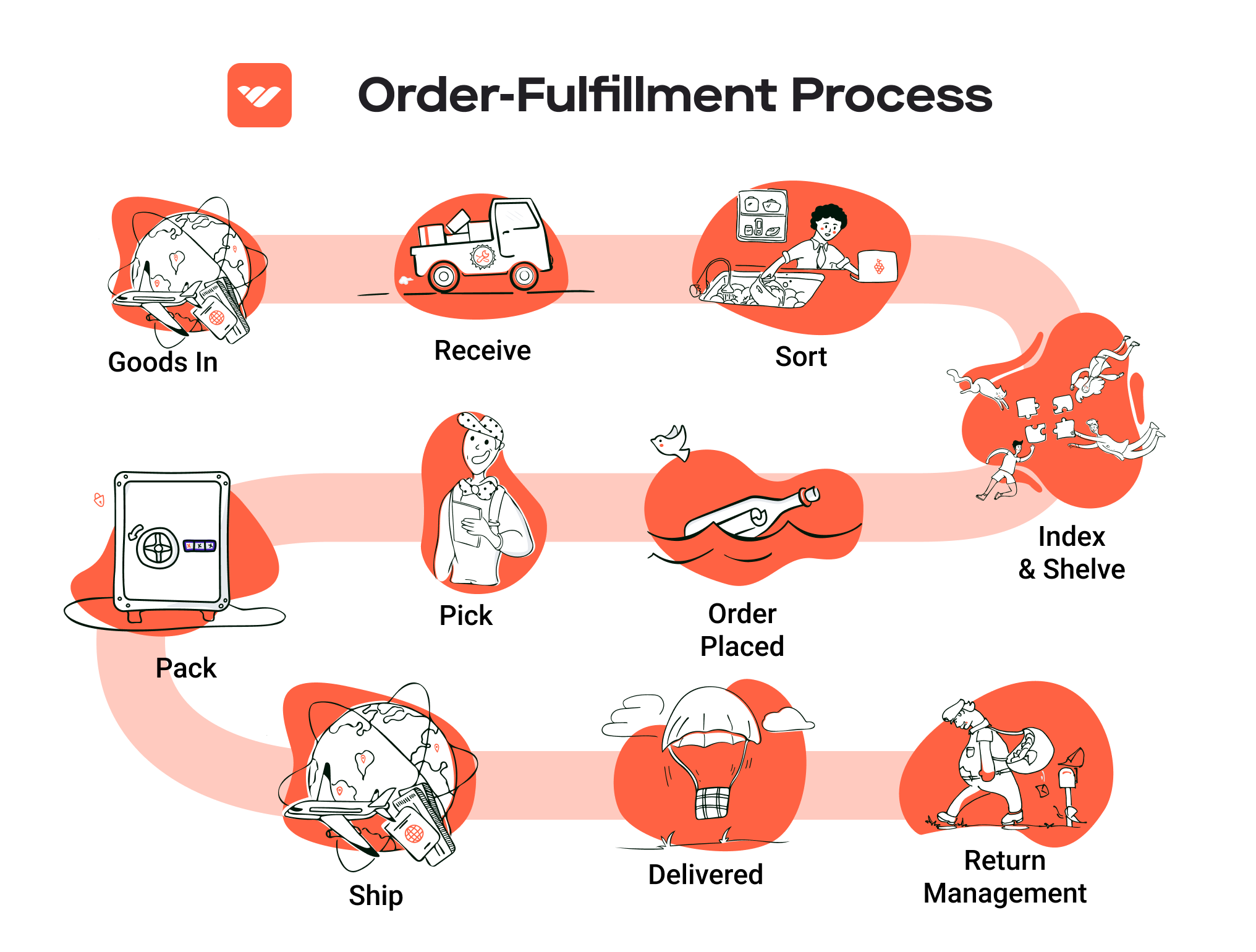
However, dropshipping comes with notable disadvantages. Profit margins are typically lower compared to traditional retail models, as suppliers take a cut of the sale. Additionally, the retailer is reliant on the supplier for product quality and shipping times, which can lead to customer dissatisfaction if issues arise. Furthermore, the lack of control over inventory can result in stockouts or delays that are beyond the retailer’s control, potentially harming brand reputation.
Conclusion
When considering which fulfillment model to adopt, e-commerce business owners must evaluate their current business stage, resources, and long-term goals. In-house fulfillment offers control but requires significant investment, while 3PLs provide flexibility and expertise at the cost of some control. Dropshipping allows for low-risk entry but can limit profitability and customer satisfaction. Each model has its unique advantages and challenges, and the right choice will depend on the specific needs and growth trajectory of the business.
A Deep Dive into Amazon FBA: Pros, Cons, and Who It’s For
What is Fulfillment by Amazon (FBA)?
Fulfillment by Amazon (FBA) is a service that allows e-commerce sellers to store their products in Amazon’s fulfillment centers. Amazon then takes care of storage, packaging, and shipping of these products directly to customers. This service simplifies logistics for sellers, enabling them to focus on other aspects of their business, such as marketing and product development.
Once a seller enrolls in FBA, they send their inventory to Amazon’s warehouses. When a customer places an order, Amazon picks, packs, and ships the product on behalf of the seller. Additionally, Amazon handles customer service and returns for those orders. This integration with Amazon’s robust logistics network allows sellers to leverage Amazon’s infrastructure, ensuring faster delivery times and a seamless shopping experience for customers.
How FBA Works
-
Inventory Storage: Sellers send their products to Amazon’s fulfillment centers. Amazon provides guidelines on how to package and label items properly.
-
Order Processing: When a customer places an order for a product fulfilled by FBA, Amazon’s system automatically picks the item from the warehouse.
-
Packaging and Shipping: Amazon packs the product according to its standards, affixes shipping labels, and ships it directly to the customer.
-
Customer Service: Amazon manages all customer inquiries, refunds, and returns for FBA orders, enhancing the customer experience.
-
Performance Tracking: Sellers can monitor their sales, inventory levels, and fulfillment performance through Amazon’s Seller Central dashboard.
Pros of Fulfillment by Amazon
1. Prime Eligibility
One of the most significant advantages of using FBA is that products become eligible for Amazon Prime. This status can dramatically increase visibility and sales, as Prime members tend to favor Prime-eligible products due to the benefits of fast, free shipping.
2. Customer Trust
Amazon is a well-known and trusted brand. By using FBA, sellers can leverage this trust, as customers are more likely to purchase from sellers whose products are fulfilled by Amazon. The assurance of reliable shipping and easy returns can enhance customer satisfaction and loyalty.
3. Multi-Channel Fulfillment
FBA allows sellers to fulfill orders from other sales channels (like their own websites or eBay) using Amazon’s logistics. This multi-channel fulfillment capability can streamline operations for businesses selling across various platforms, maintaining a consistent customer experience.
4. Scalability
FBA provides a scalable solution for growing businesses. As order volumes increase, sellers can easily send more inventory to Amazon without the need to invest in their own warehousing and logistics infrastructure.
5. Time Savings
By outsourcing logistics to Amazon, sellers save time and resources that can be redirected towards other critical business functions, such as marketing and product development.
Cons of Fulfillment by Amazon
1. High Fees
FBA comes with various fees, including storage fees for keeping inventory in Amazon’s warehouses and fulfillment fees for each order shipped. These costs can add up, especially for sellers with lower-margin products.
2. Strict Inventory Rules
Amazon has specific guidelines regarding inventory management, including requirements for labeling and packaging. Sellers must adhere to these rules to avoid penalties or issues with their inventory.
3. Commingling Risks
FBA operates on a commingling basis, meaning that inventory from different sellers can be stored together. This can pose risks for sellers if customers receive items from other sellers under their brand name, leading to potential quality control issues and negative customer experiences.
4. Limited Control
By using FBA, sellers relinquish some control over the fulfillment process. This can be concerning for businesses that prefer to maintain direct oversight of shipping and handling to ensure quality and customer satisfaction.
5. Inventory Management Challenges
Managing inventory across multiple fulfillment centers can be complex. Sellers must monitor stock levels closely and account for potential delays in restocking, which can impact their ability to fulfill customer orders promptly.
Who is FBA Best For?
Fulfillment by Amazon is best suited for:
-
Small to Medium-Sized Businesses: Businesses that are scaling and looking to leverage Amazon’s logistics without investing heavily in their own infrastructure can benefit significantly from FBA.
-
Product-Based Companies: Sellers with physical products that can be easily stored and shipped are prime candidates for FBA.
-
E-commerce Entrepreneurs: Individuals looking to enter the e-commerce space without the logistical burden of handling fulfillment can use FBA to simplify operations.
-
Brands Seeking Growth: Companies aiming to increase their market presence and take advantage of Amazon’s vast customer base can leverage FBA to reach a wider audience.
In conclusion, while FBA provides numerous advantages, such as increased visibility, customer trust, and operational efficiency, it also comes with challenges like high fees and inventory management complexities. Businesses should carefully evaluate their specific needs and resources before deciding if FBA aligns with their growth strategy.
Core Services Offered by Fulfillment Centers
Inventory Management & Warehousing
Inventory management and warehousing are foundational services provided by fulfillment centers, designed to streamline the storage and retrieval of products for e-commerce businesses. Fulfillment centers, like the Amazon facility in Shakopee, utilize advanced technologies, including autonomous robots and sophisticated inventory management systems, to optimize space and maintain accurate stock levels.
What It Is: Inventory management involves tracking product quantities, locations, and movements within the warehouse. Fulfillment centers store products in a systematic manner, often utilizing a random storage method, where items are stored based on availability rather than a fixed location. This method enhances space utilization and speeds up retrieval times.
Benefits: For e-commerce businesses, efficient inventory management translates to reduced holding costs and improved order accuracy. With real-time data on inventory levels, businesses can make informed purchasing decisions, minimizing the risk of stockouts or overstock situations. This agility allows companies to respond quickly to market demands and seasonal fluctuations, ultimately enhancing customer satisfaction through timely deliveries.
Pick and Pack Services
Pick and pack services are critical to the fulfillment process, where products are selected from inventory and prepared for shipment to customers. This service is particularly vital for e-commerce businesses that require precise order fulfillment to meet customer expectations.
What It Is: In the pick and pack process, fulfillment center staff or automated systems retrieve items from their storage locations based on customer orders. Once picked, items are packed into shipping boxes, with necessary materials to ensure safe transit. The process typically includes labeling and preparing the package for shipment.
Benefits: The efficiency of pick and pack services directly impacts delivery times and order accuracy. By outsourcing this process to a fulfillment center, e-commerce businesses can focus on core activities like marketing and product development while ensuring that orders are fulfilled quickly and accurately. Additionally, advanced packing techniques can reduce shipping costs and enhance the overall unboxing experience for customers.
Kitting and Assembly
Kitting and assembly services offered by fulfillment centers are designed for businesses that sell products requiring assembly or that want to offer bundled items. This service is particularly useful for brands looking to create unique product offerings or to simplify the purchasing experience for customers.
What It Is: Kitting involves the assembly of multiple products into a single package or kit, which may include items that are complementary or related. For instance, a fulfillment center might combine a camera, lens, and tripod into one kit for sale. Assembly services may also be needed for products that require setup before shipping, such as furniture or electronic devices.
Benefits: Kitting and assembly can streamline the purchasing process for consumers by providing ready-to-use products. This not only enhances customer satisfaction but can also increase average order value by encouraging customers to buy related items together. For e-commerce businesses, this service can reduce the complexity of inventory management and simplify fulfillment logistics, as products can be shipped as single units rather than multiple components.
Returns Management (Reverse Logistics)
Returns management, or reverse logistics, is a crucial service for e-commerce businesses, as it involves handling the return of products from customers. Effective returns management can significantly impact customer loyalty and overall business profitability.
What It Is: Returns management encompasses the processes involved in receiving returned items, inspecting their condition, restocking them, or managing their disposal if necessary. Fulfillment centers often implement streamlined processes to handle returns efficiently, ensuring that items are quickly processed and either returned to inventory or appropriately handled.
Benefits: A well-managed returns process can enhance customer trust and satisfaction. By providing a hassle-free return experience, e-commerce businesses can improve customer retention and encourage repeat purchases. Additionally, effective returns management allows businesses to recover value from returned products, minimizing losses. It also provides valuable insights into customer behavior and product performance, enabling businesses to make informed decisions about inventory and product offerings.
Conclusion
Fulfillment centers like the Amazon facility in Shakopee, Minnesota, offer a comprehensive suite of services that are integral to the success of e-commerce businesses. By leveraging advanced inventory management, efficient pick and pack services, kitting and assembly, and robust returns management, companies can scale their operations effectively while maintaining a high level of customer satisfaction. As e-commerce continues to grow, partnering with a capable fulfillment center can provide the operational support necessary to thrive in a competitive marketplace.
How to Choose a Fulfillment Partner: A 6-Point Checklist
Location & Warehouse Network
Importance: The location of your fulfillment partner is crucial for ensuring timely delivery and minimizing shipping costs. A strategically placed warehouse network can significantly impact your logistics efficiency, especially if you serve a wide geographic area.
Questions to Ask:
– Where are your warehouses located, and how does that align with my target market?
– Do you have multiple facilities to handle regional distribution?
– How do you manage transportation from your warehouses to customers?
– Can you provide estimated shipping times based on my customer demographics?
Technology & Integrations
Importance: A fulfillment partner’s technology can streamline operations and improve accuracy. The ability to integrate with your e-commerce platform, inventory management systems, and customer service tools is essential for real-time visibility and efficient order processing.
Questions to Ask:
– What software do you use for inventory management, and how does it integrate with my current systems?
– Can you provide real-time tracking information for orders?
– How do you handle updates to inventory levels, and how frequently are these updates made?
– What reporting capabilities do you offer for analyzing shipping and fulfillment performance?
Specializations (e.g., Cold Storage, Oversized Items)
Importance: Depending on your product range, you may require a partner with specific capabilities. Whether you sell perishables that need cold storage or oversized items that require special handling, ensuring your fulfillment partner has the right infrastructure is vital.
Questions to Ask:
– What types of products do you specialize in handling?
– Do you have specific facilities for temperature-sensitive items?
– How do you manage the storage and shipping of oversized or fragile items?
– Can you accommodate unique packaging or labeling requirements for my products?
Scalability & Capacity
Importance: As your business grows, your fulfillment needs will change. A partner that can scale with you will help you avoid disruptions in service and ensure you can meet demand during peak seasons.
Questions to Ask:
– How do you handle fluctuations in order volume, especially during peak seasons?
– What is your current capacity, and how quickly can you expand if my order volume increases?
– Do you have contingency plans in place for unexpected surges in demand?
– How do you manage staffing during busy periods?
Pricing and Contracts
Importance: Understanding the pricing structure and contractual obligations will help you avoid unexpected costs and ensure that the partnership aligns with your financial goals. Transparency in pricing is critical to maintaining profitability.
Questions to Ask:
– Can you provide a detailed breakdown of your pricing model (e.g., storage fees, shipping costs, pick and pack fees)?
– Are there any additional charges I should be aware of (e.g., for returns or special handling)?
– What is the length of the contract, and are there any penalties for early termination?
– How often do you review your pricing, and how will increases be communicated?
Customer Support & Reviews
Importance: Reliable customer support can make or break a partnership. The ability to communicate effectively and resolve issues quickly is essential for maintaining smooth operations and customer satisfaction.
Questions to Ask:
– What type of customer support do you offer (e.g., dedicated account manager, 24/7 support)?
– How quickly can I expect a response to inquiries or issues?
– Can you provide references or case studies from similar businesses?
– What is your process for handling complaints or disputes?
Conclusion
Choosing the right fulfillment partner is a critical decision that can significantly influence your e-commerce operations. By using this checklist, you can ensure that you evaluate potential partners comprehensively, aligning their capabilities with your business needs. Remember, a strategic partnership in fulfillment not only enhances your logistics efficiency but also contributes to your overall customer experience.
Understanding Fulfillment Pricing: A Breakdown of Common Fees
Initial Setup Fees
Initial setup fees are typically charged by fulfillment centers to cover the costs associated with onboarding a new client. This can include the integration of your inventory management systems, configuring your account, and setting up any necessary software or processes that will facilitate your order fulfillment.
These fees can vary significantly based on the complexity of your operations and the fulfillment center’s capabilities. For instance, a simple setup for a small business might incur a fee in the range of $200 to $500, while more complex setups for larger businesses with extensive inventory systems could range from $1,000 to several thousand dollars.
To minimize initial setup costs, consider negotiating with your chosen fulfillment center about waiving or reducing these fees in exchange for a longer-term contract or higher volume commitments.
Receiving Fees
Receiving fees are charged when your products arrive at the fulfillment center. This fee covers the labor and resources required to unload, inspect, and inventory your goods.
Typically, receiving fees are calculated per unit or per pallet. For example, you might see charges such as $0.50 to $1.50 per item received or a flat rate of $20 to $50 per pallet. The specific fee can depend on the nature of your products and the fulfillment center’s operational processes.
To reduce receiving fees, ensure that your shipments are organized and labeled correctly, as this can speed up the receiving process and minimize handling time.
Storage Fees (per pallet/bin)
Storage fees are incurred for the space your inventory occupies within the fulfillment center. These fees are generally calculated on a monthly basis and can be charged per pallet or per bin, depending on how your products are stored.
For instance, storage fees might range from $10 to $30 per pallet per month or $2 to $5 per bin, depending on the fulfillment center’s pricing structure and the volume of inventory. Additionally, some centers may offer tiered pricing; the more pallets you store, the lower the per-pallet fee might be.
To manage storage costs effectively, analyze your inventory turnover rates. Maintaining a lean inventory can help avoid excess storage fees. Implementing just-in-time inventory practices could further minimize costs.
Pick & Pack Fees (per item/order)
Pick and pack fees are charged for the labor involved in selecting items from inventory and packaging them for shipment. This fee is typically structured on a per-item or per-order basis.
For example, you might encounter fees ranging from $0.50 to $2.00 per item picked, or a flat rate of $2 to $5 per order. Variations in fees can arise based on the complexity of the packing process, including the need for special packaging or additional materials.
To optimize pick and pack costs, consider streamlining your product offerings or packaging requirements. The less complex the order, the lower your overall fulfillment costs will be.
Shipping Fees
Shipping fees are one of the most significant components of fulfillment pricing. These fees cover the cost of transporting your products from the fulfillment center to the customer. Shipping costs are influenced by several factors, including package dimensions, weight, shipping method, and destination.
Fulfillment centers usually offer various shipping options, ranging from standard to expedited shipping, each with different costs. For instance, shipping fees may range from $5 to $20 for standard shipping, while expedited options could be considerably higher, depending on the service level chosen.
To reduce shipping costs, leverage the fulfillment center’s partnerships with major carriers. Many fulfillment centers negotiate discounted shipping rates that can be passed on to their clients. Additionally, consider optimizing your packaging to reduce dimensions and weight, which can significantly lower shipping fees.
Tips for Getting an Accurate Quote
To obtain an accurate quote from a fulfillment center, follow these guidelines:
- Be Transparent: Provide detailed information about your products, including dimensions, weight, and any special handling requirements.
- Understand Your Needs: Clearly outline your expected order volume and fulfillment frequency to allow the center to provide a tailored quote.
- Request Itemized Pricing: Ask for a breakdown of all potential fees, including setup, receiving, storage, pick & pack, and shipping fees. This will help you identify areas for cost savings.
- Negotiate Terms: Don’t hesitate to negotiate terms and pricing based on your expected order volumes or the length of the contract.
- Review Regularly: As your business grows, regularly revisit your fulfillment agreement to ensure it remains aligned with your operational needs and is cost-effective.
By understanding these common fees and how they are calculated, you can make informed decisions that will help streamline your fulfillment processes and ultimately support your growth as an e-commerce business.
Frequently Asked Questions (FAQs) about Fulfillment
1. What is the Amazon fulfillment center in Shakopee, Minnesota?
The Amazon fulfillment center in Shakopee is a massive, 820,000-square-foot facility that plays a critical role in Amazon’s logistics network. It is designed to process, store, and ship products efficiently, utilizing advanced technology, including autonomous robots, to streamline operations. Opened in 2016, it can accommodate up to 1,000 employees and is strategically located to serve a wide customer base.
2. How does the fulfillment process work at the Shakopee center?
At the Shakopee fulfillment center, products arrive and are stowed in a randomized manner within shelving units known as pods. When an order is placed, robots retrieve the necessary items and transport them to packing stations. Workers then package the items and apply shipping labels based on barcodes scanned during the process, ensuring a seamless and efficient operation.
3. What is the difference between a warehouse and a fulfillment center?
A warehouse primarily serves as a storage space for goods, where products are held until needed. In contrast, a fulfillment center focuses on the entire order processing workflow, including storage, picking, packing, and shipping of products directly to customers. Fulfillment centers are designed to handle high volumes of orders and emphasize quick turnaround times.
4. What are the benefits of using Amazon’s fulfillment services?
Using Amazon’s fulfillment services allows businesses to leverage Amazon’s extensive logistics network, which can lead to faster shipping times and improved customer satisfaction. Additionally, businesses benefit from Amazon’s technology, including inventory management and order tracking systems, which can enhance operational efficiency and reduce overhead costs.
5. What is a 3PL (Third-Party Logistics)?
A 3PL, or Third-Party Logistics provider, is a company that offers logistics services to businesses, including warehousing, transportation, and fulfillment. By outsourcing logistics to a 3PL, businesses can focus on their core operations while benefiting from the 3PL’s expertise and infrastructure, often resulting in cost savings and improved service levels.
6. How much do fulfillment services cost?
Fulfillment service costs can vary widely based on several factors, including the volume of orders, the types of products being handled, and the specific services required (such as storage, packing, and shipping). Generally, costs may include fees for receiving inventory, monthly storage fees, per-order fulfillment fees, and shipping charges. It’s advisable for businesses to evaluate their specific needs and obtain quotes from multiple providers for accurate cost comparisons.
7. What types of products can be stored and fulfilled at the Shakopee center?
The Shakopee fulfillment center can handle a wide range of products, including electronics, household items, clothing, and more. However, certain restrictions may apply to hazardous materials or perishable goods. It is essential for businesses to verify product eligibility and comply with Amazon’s guidelines when using their fulfillment services.
8. How does Amazon ensure the safety of workers in the fulfillment center?
Amazon has implemented various safety measures in its fulfillment centers, including regular training programs, ergonomic assessments, and safety equipment requirements. Despite these efforts, there have been criticisms regarding working conditions. Amazon continues to adapt its safety protocols and invest in technology to minimize risk and improve overall workplace safety.
9. Can I visit the Amazon fulfillment center in Shakopee?
Yes, the Amazon fulfillment center in Shakopee offers public tours, allowing visitors to see the operations firsthand. Tours are typically limited in size and may require advance booking. This initiative aims to engage with the community and provide transparency about Amazon’s fulfillment processes.
10. How can businesses get started with Amazon fulfillment services?
To start using Amazon’s fulfillment services, businesses need to sign up for the Amazon FBA (Fulfillment by Amazon) program. This involves creating an Amazon seller account, listing products, and shipping inventory to the fulfillment center. Once set up, businesses can manage their inventory and orders through the Amazon Seller Central platform, streamlining the fulfillment process.
Conclusion: Is Outsourcing Fulfillment the Right Move for Your Business?
The Case for Outsourcing Fulfillment
Outsourcing fulfillment can be a transformative decision for your e-commerce business. The primary benefits include significant time savings, enhanced scalability, and access to specialized expertise. By partnering with a fulfillment service, you can redirect your focus from logistics to core business activities such as marketing and customer engagement. This shift allows you to enhance your operational efficiency and ultimately drive sales growth.
Scalability is another crucial advantage. As your business experiences fluctuations in demand—whether seasonal peaks or unexpected surges—an experienced fulfillment partner can adapt to these changes seamlessly. This flexibility ensures that you can meet customer expectations without the burden of overextending your resources or incurring unnecessary costs.
Moreover, fulfillment centers often bring with them a wealth of expertise in logistics and inventory management. They utilize advanced technologies, such as automation and data analytics, to optimize the fulfillment process. This expertise can lead to improved order accuracy and faster shipping times, both of which are critical in today’s competitive e-commerce landscape.
However, choosing the right fulfillment partner is essential for maximizing these benefits. Conduct thorough research and consider factors such as location, technology capabilities, and service offerings. Your fulfillment partner should align with your business goals and provide the support you need for sustained growth.
To determine whether outsourcing fulfillment is the right next step for your business, consider conducting a comprehensive audit of your current shipping processes. Assess your operational challenges, costs, and customer satisfaction levels. This evaluation will provide clarity on whether a fulfillment service could enhance your efficiency and allow for strategic growth. Don’t hesitate—take this critical step toward elevating your e-commerce operations today.
Important Disclaimer
⚠️ Important Disclaimer
The information in this guide is for educational purposes. Fulfillment services, pricing, and platform features change frequently. Always conduct your own due diligence and consult with providers directly before making business decisions.
